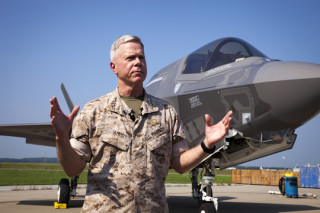
The commandant of the Marine Corps said the service’s short take-off and vertical landing (STOVL) variant of the F-35 Lighting II Joint Strike Fighter will reach initial operating capability sometime in the later half of 2015.
Gen. James Amos said that means 10 of the 16 planes assigned to a squadron would be in place with aircrews and maintainers fully trained and shipboard qualified, he said Wednesday at the Brookings Institution in Washington, D.C.
The F-35Bs will begin replacing the Marine Corps eight squadrons of AV-8B Harriers with the last Harrier are to leave the Marine’s inventory in the 2020s.
The Air Force and Navy have until Friday to report to Congress when they expect their variants of the F-35s to achieve initial operating capability.
Amos stressed the STOVL are important to the service for a variety of missions afloat and ashore, capable of landing and operating off highways as the Harriers did in the invasion of Iraq in 2003, instead of 8,000 foot runways.
Amos said the Amphibious Combat Vehicle remains in research and development, and he expects to make a decision on whether it should be a high-speed 28 knot vehicle or similar to the Marine Corps current 40 year-old AAVs that transit to shore at about 8 knots, in the fall.
“Cost is a factor in this,” Amos said.
“If things go according to current plans, a request for proposal should go out to industry early next year.”
In 2011 the Marines cancelled its Expeditionary Fighting Vehicle program due to increased cost for the capability. The EFV was designed to transit from an amphibious assault ship over a distance of 25 nautical miles. The over-the-horizon transit capability was considered essential to the Navy and the Marine Corps during the EFV development to protect from the threat of low-cost guided weapon systems.
“I want [the ACV] to be like an F-150 [a large Ford pickup truck], reliable and beefy. …They are utility fighting vehicles for us,” Amos said.
“I am only going to get one more shot to get this right.”
Turning to the financial realities facing the Marine Corps and the Pentagon generally, he said, “I am not in denial about sequestration. …The real impact of sequestration [will be felt] from 2014 out for the next nine years.”
Amos said that if sequestration occurs next year, “half of my forces will be less than ready” under criteria set now for deployment. “If something happens, we will go. That’s what we do.”
The impact of the combination of cuts starting with former Defense Secretary Robert Gates’ efficiencies, the Budget Control Act of 2011, an expected Continuing Resolution for the next fiscal year rather than a budget and sequestration has already caused the Marine Corps to re-look at its dwell time between deployments.
“We’re used to rotating forces,” creating a six-months deployed to 12 months at home cycle now, he said. At the height of the fighting in Iraq, the ratio was roughly seven months deployed, seven months back and deployed again.
“That began to wear on the force,” and he said the Marine Corps wanted to have a six months to 18 months at home or six months to 24 months at home.
“Families aren’t going to too thrilled,” Amos said.
Briefly touching on providing Marines for increased embassy and consulate security, he said that it is likely they will be counted against end-strength. When the increased Marine presence at 12 State Department overseas facilities would be not included in the end strength of 182,100.





